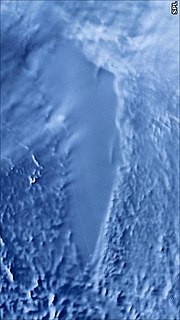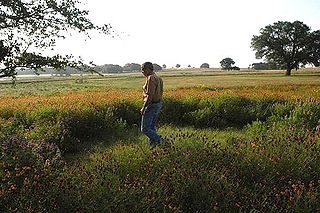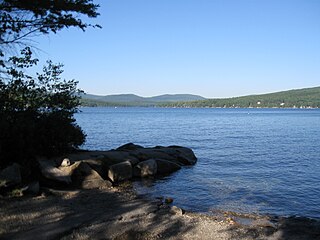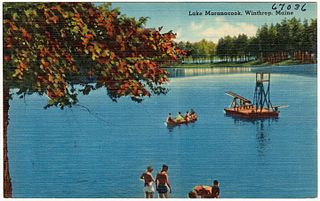
Lake Vostok is the largest of Antarctica's almost 400 known subglacial lakes.
Lake Vostok is located at the southern Pole of Cold, beneath Russia's Vostok Station under the surface of the central East Antarctic Ice Sheet, which is at 3,488 m (11,444 ft) above mean sea level. The surface of this fresh water lake is approximately 4,000 m (13,100 ft) under the surface of the ice, which places it at approximately 500 m (1,600 ft) below sea level.

The water cycle, also known as the hydrologic cycle or the hydrological cycle, describes the continuous movement of water on, above and below the surface of the Earth. The mass of water on Earth remains fairly constant over time but the partitioning of the water into the major reservoirs of ice, fresh water, saline water and atmospheric water is variable depending on a wide range of climatic variables. The water moves from one reservoir to another, such as from river to ocean, or from the ocean to the atmosphere, by the physical processes of evaporation, condensation, precipitation, infiltration, surface runoff, and subsurface flow. In doing so, the water goes through different forms: liquid, solid (ice) and vapor.

Prairie Chapel Ranch is a 1,583-acre (6.4 km²) ranch in unincorporated McLennan County, Texas, located 7 miles (11 km) northwest of Crawford. The property was acquired by George W. Bush in 1999 and was known as the Western White House during his presidency. Bush spent vacation time at the house, where he also entertained visiting dignitaries from around the world. The ranch received its name from the Prairie Chapel School which was built nearby on land donated by mid-19th century German immigrant Heinrich Engelbrecht from Oppenwehe, Germany, who owned the land that now comprises the Bush ranch. Engelbrecht also donated land for the nearby Canaan Baptist Church.

Lake Como is a lake of glacial origin in Lombardy, Italy. It has an area of 146 square kilometres (56 sq mi), making it the third-largest lake in Italy, after Lake Garda and Lake Maggiore. At over 400 metres deep, it is one of the deepest lakes in Europe, and the bottom of the lake is more than 200 metres (660 ft) below sea level.

Yungaburra is a town located on the Atherton Tableland in Far North Queensland, Australia, not far from Cairns. In the 2011 census, Yungaburra had a population of 1,116 people.

Wakiso District is a district in the Central Region of Uganda that partly encircles Kampala, Uganda's capital city. The town of Wakiso is the site of the district headquarters.
Lake retention time is a calculated quantity expressing the mean time that water spends in a particular lake. At its simplest, this figure is the result of dividing the lake volume by the flow in or out of the lake. It roughly expresses the amount of time taken for a substance introduced into a lake to flow out of it again. The retention time is especially important where pollutants are concerned.

A reservoir is, most commonly, an enlarged natural or artificial lake, pond or impoundment created using a dam or lock to store water.

The Malayan water shrew, also known as the hantu water shrew, is a red-toothed shrew recorded only from the Malaysian state of Selangor. It was listed as a critically endangered, but is now considered near threatened.

Merrymeeting Lake is a 1,233-acre (4.99 km2) water body located in Strafford County in eastern New Hampshire, United States, in the town of New Durham. Its outlet is the Merrymeeting River, flowing south and then northwest to Lake Winnipesaukee.

Freshwater fish are those that spend some or all of their lives in fresh water, such as rivers and lakes, with a salinity of less than 0.05%. These environments differ from marine conditions in many ways, the most obvious being the difference in levels of salinity. To survive fresh water, the fish need a range of physiological adaptations.

Lake Lashaway is a 293-acre (1.19 km2) pond located near the East Brookfield and North Brookfield, Massachusetts town line. The town line cuts the lake approximately in half. The lake lies just to the north of state Route 9 as it passes through East Brookfield.

The Executive Residence, known better as the Governor's Mansion, is located at 99 Cambridge Road in the Village of Maple Bluff, Wisconsin, on the eastern shore of Lake Mendota. It is currently the official residence of Wisconsin Governor Tony Evers.

Lake Boon is a lake in eastern Massachusetts covering about 163 acres (0.66 km2) in the towns of Stow and Hudson, Massachusetts. It has been an important part of the Stow and Hudson communities since the towns originated. It was originally named "Boon Pond" after Matthew Boon, an explorer from Charlestown, Massachusetts, who came to the area in 1660. He was the first of two settlers in Stow and was killed by Native Americans near the Lake on about February 14, 1676. In 1883 a monument was erected in memory of him.

Lake Lagunita is an artificial dry lake in Stanford University, California, located on the western side of the Stanford campus near the Lagunita residences.
The Spavinaw Water Project was a water project to provide water for Tulsa, Oklahoma.

Pashan Lake is an artificial lake near the suburb of Pashan, about 12 km from the city center of Pune, India. The lake was built in the British era to accommodate the water requirement of the neighbourhood. The main inlet of the lake is a small rivulet, which is even controlled by the barrage located to the north of the lake. The rivulet originates from Bavdhan and flows via Pashan, Sutarwadi, Baner to Someshwarwadi before flowing into the main Mula river. Pashan lake has a total catchment area of 40 square kilometres (15 sq mi), and serves as a source of water to the old Pashan village, and the Governor's residence, as well. Recent urbanisation around the lake has led to the fall in the quality of the water.

Damdamaa reservoir in Sohna, district in the Indian state of Haryana. It is one of the biggest lakes in Haryana and with an area of 3,000 acres (12.14 km2). Damdama Lake was formed when a stone and earthen dam constructed by the British was commissioned for rain water harvesting in 1947. The lake, held by an embankment, is fed mainly by monsoon rain pouring into a trough at the base of the Aravali hills. The Lake greets visitors with a water level down to 20 ft (6.1 m). During monsoon the water level reaches up to 50 ft (15 m) - 70 ft (21 m).

Maranacook Lake is a body of water in Kennebec County, Maine located in the towns of Readfield, Maine and Winthrop, Maine. The lake covers 1,673 acres (677 ha) with a maximum depth of 118 feet (36 m) and a mean depth of 30 feet (9.1 m). It is one of the major bodies of water in the Winthrop Lakes Region.
















